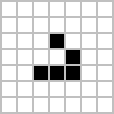Period
The period of a pattern is the smallest number of generations it takes for it to reappear in its original form, possibly with some slight modification of interest. The term is used most commonly for oscillators and spaceships, but can also be used for puffers, wicks, fuses, superstrings, factories and guns. In the last case there is a distinction between true period and pseudo period. There is also a somewhat different concept of period for wicktrailers.
Oscillators

In the case of oscillators, the period refers simply to the minimum number of generations it takes for the pattern to reappear exactly as it started. The period is equal to the number of distinct phases of the pattern. For example, the blinker is a period 2 oscillator because it has two distinct phases: one in which the three alive cells are arranged horizontally, and one in which the three alive cells are arranged vertically.
The period of an oscillator takes orientation into account. That is, even though the two phases of the blinker look the same from different orientations, they are considered two distinct phases and thus its period is 2. Also consider mold, which has period 4 even though its mirror image appears after only 2 generations.
Spaceships

For spaceships, the period refers to the minimum number of generations it takes for the pattern to reappear as it started, but at a different location. The period of a spaceship has nothing to do with how much the spaceship is displaced; only how long it takes for it to reappear. For example, the glider is a period 4 spaceship as can be seen to the right.
The period of a spaceship takes orientation into account. That is, even though the the glider appears mirrored after only 2 generations, its period is 4.